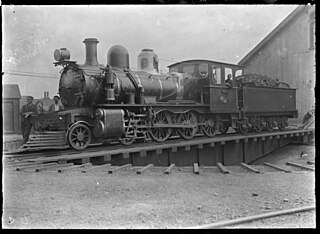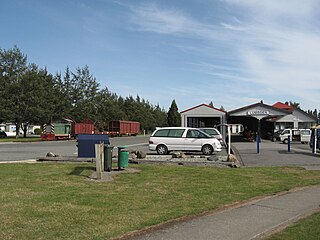
Railway preservation in New Zealand is the preservation of historically significant facets of New Zealand's rail transport history. The earliest recorded preservation attempt took place in 1925, although the movement itself did not start properly until 1960.

The Bealey River is a small river located in the Southern Alps of New Zealand. It is a tributary of the Waimakariri River. Its valley forms the eastern approach to Arthur's Pass. The river and the Bealey settlement are named for Samuel Bealey, a 19th-century Superintendent of Canterbury Province and pastoralist.

The New Zealand F class was the first important class of steam locomotive built to operate on New Zealand's railway network after the national gauge of 3 ft 6 in was adopted. The first locomotives built for the new gauge railways were two E class double Fairlies for the Dunedin and Port Chalmers Railway Company. The F class was the first class ordered by the central government, and between 1872 and 1888, a total of eighty-eight members of the class were constructed.

The Plains Vintage Railway & Historical Museum is a heritage railway and recreated historic village in the Tinwald Domain, Tinwald, New Zealand. The railway runs on approximately three kilometres of rural railway line that was once part of the Mount Somers Branch. The village and railway are open regularly to the public. The railway utilises preserved and restored locomotives and rolling stock once used on New Zealand's national railway network, while the village shows visitors how life was lived in New Zealand's pioneering past.
Locomotives of New Zealand is a complete list of all locomotive classes that operate or have operated in New Zealand's railway network. It does not include locomotives used on bush tramways.
The Ohai Line, formerly known as the Ohai Industrial Line and previously the Wairio Branch and the Ohai Railway Board's line, is a 54.5 km branch line railway in Southland, New Zealand. It opened in 1882 and is one of two remaining branch lines in Southland, and one of only a few in the country. A number of smaller privately owned railways fanned out from Wairio; one of these lines, to Ohai, was originally built by the Ohai Railway Board and was worked by New Zealand Railways from 1990 and incorporated into the national network in 1992.

The NZR WB class was a class of tank locomotives that operated in New Zealand. Built in 1898 by the Baldwin Locomotive Works, the twelve members of the class entered service during the first five months of 1899. Eight were withdrawn by the end of 1935, while four others survived with new boilers until the mid-1950s.

The NZR WD class was a class of tank locomotive built by Baldwin Locomotive Works to operate on New Zealand's national rail network.

The Wellington and Manawatu Railway Trust is a charitable trust based in Wellington, New Zealand, and is actively restoring former Wellington and Manawatu Railway locomotive No.9, to full working order.

The P class was a class of steam locomotives built to haul freight trains on the national rail network of New Zealand. The class consisted of ten individual locomotives ordered from the British company of Nasmyth, Wilson and Company in 1885, but miscommunications about the weight limitations imposed on the locomotives meant they did not start work until 1887. This debacle came at a time when the New Zealand Railways Department (NZR) was suffering from a lack of motive power to work on its rapidly expanding network and was part of what prompted a shift towards American and home-grown manufacturers.

The NZR LA class was a class of 4-4-0T steam locomotives used by the New Zealand Railways Department and the New Zealand Midland Railway Company. They were built by Nasmyth, Wilson and Company in 1887 for New Zealand Midland Railway Company, and were taken over by NZR in 1900, when the government acquired the incomplete Midland line. The designation also applies to the NZR 4-4-0Trebuilds of the Avonside L class of 1875 which were later reclassified LB after being rebuilt as 4-4-2Ts.

The New Zealand V class steam locomotive was used on New Zealand's railway network from 1885 onwards. They were operated by New Zealand Government Railways and the Wellington and Manawatu Railway Company.

The NZR FA class was a class of tank steam locomotives that was built as a larger version of the NZR F class 0-6-0T. The requirements were for larger water and coal capacity on a locomotive that could handle grades better than the F class. Due to costs involved in producing new machines, NZR chose to rebuild existing machines with larger coal and water capacity, larger boiler and firebox, higher boiler pressure and larger diameter pistons. Seven F class engines were rebuilt between 1892 and 1897. Another seven were built new, one at Newmarket Workshops in 1896 and six at Addington Workshops in 1902–03.

Omoto locomotive dump is a New Zealand Railways locomotive and rolling stock dump site located near Greymouth, New Zealand. The dump site is located on the southern bank of the Grey River, close to the Midland Line and State Highway 6.

Oamaru locomotive dump was created in New Zealand so that obsolete locomotives and rolling stock could be used to stabilize loose ground where rivers and the coast were eroding the ground where the railway lines were built. This was done at a time when scrap steel was an uneconomic proposition. It was located on the coastline in the North Otago town of Oamaru to stabilise land used by New Zealand Railways for their freight yards. Here the coastline of the Pacific Ocean pounded heavily against the land causing major erosion.

The NZR U class, the first tender locomotives built in New Zealand, were a class of 4-6-0 Ten Wheeler locomotive designed to the requirements of Mr T. F. Rotherham and built at NZR Addington between 1894 and 1903. They were amongst NZRs' longest lived tender engines.

The NZR UC class were a group of ten 4-6-0 steam locomotives obtained from Scottish builders Sharp, Stewart and Company for New Zealand Railways (NZR). Essentially they were developments of the firm's previous batch of 4-6-0s' for NZR.
The Ohai Railway Board Heritage Trust is a defunct railway preservation society that was formed to preserve Southland's rail history. The trust was formerly based at Wairio on the Wairio Branch in the former Ohai Railway Board workshops, and owned a number of locomotives and items of rolling stock, including the remains of two P class 2-8-0 tender locomotives.
The Ohai Railway Board (ORB) was a short railway in Southland, New Zealand. The railway line itself still exists as the Ohai branch line, but the ORB was dissolved in 1990, and in 1992 the Southland District Council sold the board's assets to New Zealand Rail Limited.

The Lumsden Heritage Trust was formed in November 2013 to preserve the past, promote the future and provide an attraction for visitors. The trust has two ex-AFFCO locomotives that were formerly preserved by the Goldfields Railway, the chassis of P 60, ex-New Zealand Railways (NZR) wagons that were formerly preserved by the Ohai Railway Board Heritage Trust, a railway station including a crane next to it and a jail from the Lumsden camping grounds.















